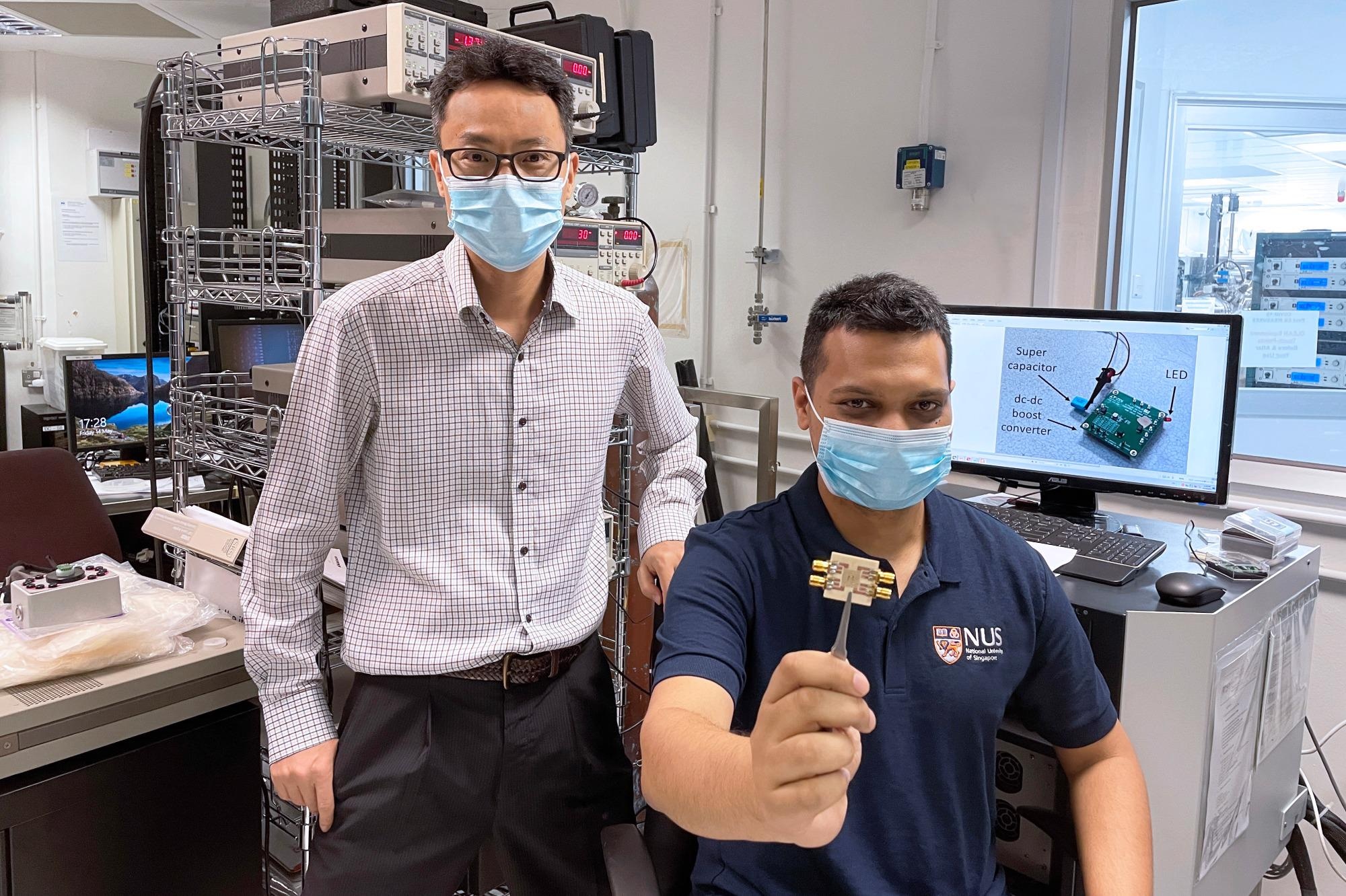May 19 2021
The rise of the digital age has significantly increased the number of WiFi sources required to send data wirelessly between devices.
 The research breakthrough was achieved by a team led by Professor Yang Hyunsoo (left). Dr Raghav Sharma (right), the first author of the paper, is holding a chip embedded with about 50 spin-torque oscillators. Image Credit: National University of Singapore.
The research breakthrough was achieved by a team led by Professor Yang Hyunsoo (left). Dr Raghav Sharma (right), the first author of the paper, is holding a chip embedded with about 50 spin-torque oscillators. Image Credit: National University of Singapore.
This leads to extensive use of the 2.4 GHz radio frequency used by WiFi, with surplus signals available to be explored for other applications.
Therefore, to exploit this under-utilized energy source, researchers from the National University of Singapore (NUS) and Tohoku University (TU) in Japan have devised a new technology that employs miniature smart devices, called spin-torque oscillators (STOs), to harvest and transform wireless radio frequencies into energy to fuel small electronics.
During their analysis, the investigators used WiFi-band signals and effectively harvested energy to fuel a light-emitting diode (LED) wirelessly and without utilizing any kind of battery.
We are surrounded by WiFi signals, but when we are not using them to access the Internet, they are inactive, and this is a huge waste. Our latest result is a step towards turning readily-available 2.4 GHz radio waves into a green source of energy, hence reducing the need for batteries to power electronics that we use regularly.
Yang Hyunsoo, Professor, Department of Electrical and Computer Engineering, National University of Singapore
“In this way, small electric gadgets and sensors can be powered wirelessly by using radio frequency waves as part of the Internet of Things. With the advent of smart homes and cities, our work could give rise to energy-efficient applications in communication, computing, and neuromorphic systems,” added Professor Hyunsoo, who also spearheaded the study.
The study was performed in association with the research group of Professor Guo Yong Xin, also from the NUS Department of Electrical and Computer Engineering, and Professor Shunsuke Fukami and his research group from TU. The study results were published in the Nature Communications journal on May 18th, 2021.
Converting WiFi Signals into Usable Energy
Spin-torque oscillators (STOs) are a group of evolving devices that produce microwaves and are used in wireless communication systems. But the application of STOs is limited because of a broad linewidth and low output power.
Although mutual synchronization of various STOs is one way to resolve this issue, existing schemes, like short-range magnetic coupling between multiple STOs, have spatial limitations.
Conversely, long-range electrical synchronization using vortex oscillators has limited frequency responses of just a few hundred MHz. Moreover, it needs specialized current sources for separate STOs, which would make the overall implementation of on-chip STO systems more complicated.
Hence, to resolve the low and spatial frequency restrictions, the researchers designed an array where eight STOs were joined in series. With the help of this array, the team converted the 2.4 GHz electromagnetic radio waves, used by WiFi, into a direct voltage signal. This signal was subsequently sent to a capacitor to illuminate a 1.6-V LED.
The researchers then charged the capacitor for 5 seconds, which allowed it to illuminate the same LED for 1 minute as soon as the wireless power was turned off.
During their analysis, the investigators also emphasized the significance of electrical topology for developing on-chip STO systems and compared the series design with the corresponding one.
The team observed that the parallel configuration is handier for wireless transmission because of better time-domain stability, control over impedance mismatch, and spectral noise behavior. Series connections, on the other hand, are advantageous for energy harvesting because of the additive effect of the diode-voltage from STO systems.
Commenting on the importance of the researchers’ results, Dr Raghav Sharma, the first author of the study, stated, “Aside from coming up with an STO array for wireless transmission and energy harvesting, our work also demonstrated control over the synchronising state of coupled STOs using injection locking from an external radio-frequency source.”
These results are important for prospective applications of synchronised STOs, such as fast-speed neuromorphic computing.
Dr Raghav Sharma, Study First Author, Department of Electrical and Computer Engineering, National University of Singapore
Next Steps
To improve the energy-harvesting potential of their new technology, the team is exploring ways to boost the number of STO systems in the array designed by them. They have also planned to test their energy harvesters to charge other useful sensors and electronic devices wirelessly.
The researchers are also hoping to collaborate with industry associates to investigate the development of on-chip STO systems for self-sustained intelligent systems, which can pave the way for wireless signal detection and wireless charging systems.
Journal Reference:
Sharma, R., et al. (2021) Electrically connected spin-torque oscillators array for 2.4 GHz WiFi band transmission and energy harvesting. Nature Communications. doi.org/10.1038/s41467-021-23181-1.